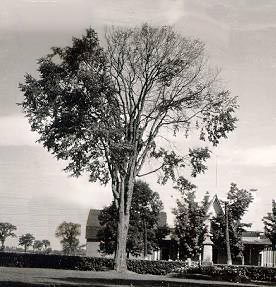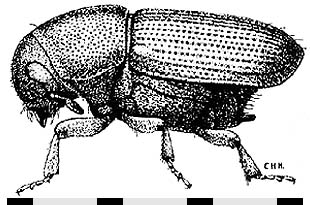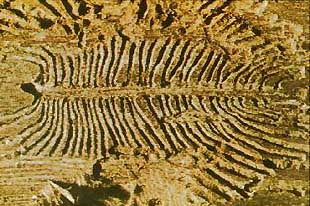
BUG OF THE MONTH SUPPLEMENT
European Elm Bark Beetle
and Dutch Elm Disease in Seattle
Scolytus multistriatus
Order Coleoptera, Family Scolytidae
Copyright © 2003 by Gerry Conley
This article originally appeared in Scarabogram, January 2003, New Series No. 273, pp. 2-4.
Dutch Elm Disease (DED) is spread from tree to tree by elm bark beetles. It has been wiping out elms in the eastern U.S. since the 1930s, and has finally arrived in Seattle after killing more than 230 elms in Tacoma since 1995. Elms have been dying of DED in Kirkland, Yarrow Point, Mercer Island, and in Seattle's Seward and Lincoln parks.
 |
| Diseased elm (UBC photo) |
Dutch Elm Disease is a fungus that attacks the tree's vascular system. It spreads though the xylem vessels in the sapwood, which conduct water and nutrients from the roots to the leaves. The trees are most susceptible to DED in the spring because then the xylem vessels are very large and long so the disease spreads quickly; summer xylem cells are short and narrow, slowing the fungal spread and giving the tree more time to react. Water flow to the leaves is cut off by the disease through a combination of clogging of the vessels by the fungus and the tree's own clogging of the vessels in an effort to seal off the infection. This leads to the characteristic first indication a tree is sick: parts of the crown show "flagging" or "wilt," leading to withering and die back of all leaves on specific branches. The infection always starts in the xylem and the spores flow naturally up to the crown, but it then moves to the roots. Once in the roots, the disease quickly spreads throughout the tree. The fungus can kill a tree within two months of damage first showing. There is no way to save a tree where the infection has gotten to the roots. The disease, called "Dutch" because it was identified by a Dutch pathologist in the 1920s, wipes out European and American elms particularly. It is believed to have originated in Asia because Asiatic elms are highly resistant to the disease.
The Roanoke Park community at the north end of Capitol Hill in Seattle has 27 historic elm trees around 85 years old. They are mostly street trees, with 7 in the park. Elms make up only 0.5% of Seattle's street trees, but 18% of Seattle's street trees over 24 inches in diameter. The community hired an arborist for advice on DED and she said "Don't trim any elms in the summer." In July, a property owner decided to ignore this advice. The larger limbs of the cut-back elms were cut to firewood size and left at the base of one of the trees. The arborist, concerned about the potential of the cut wood attracting bark beetles contaminated with DED, removed the firewood and took it to be chipped. But one large round was left behind as too large to move.
 |
| Scolytus multistriatus; black bars = mm scale from Hatch |
 |
| Scolytus multistriatus adult (Australian CSIRO drawing; yes it's there too!) |
 |
| Scolytus multistriatus larval galleries in wood (UBC photo) |
It stayed where it was in the parking strip for the next two weeks while I was gone. On my return I decided to take that piece away and debark it. It was 16" long and about 14" in diameter. As I removed the bark I found the piece infested with bark beetles which I later identified as Scolytus multistriatus, the European elm bark beetle, a known carrier of the DED fungus. I have since learned that elm bark beetles are highly attracted to the odor of fresh dead wood and that firewood is particularly susceptible to infestation; very large populations build over a period of two years in wood that is stacked and protected. As I excavated, it became clear that this piece of wood had attracted over 100 adult bark beetles in just two weeks! (I have since found the basis for calculating that over a two-year period this single piece of wood could have generated 29,000 new beetles!) Most of the beetles had just reached the cambium layer with short galleries. Very few galleries were over a half-inch long and very few were showing the female pattern of laying eggs on each side of the finished galleries which are 1.5 inches. None showed any path from the main gallery as occurs as the young burrow away from the main gallery. It was striking that some areas of the log had beetles burrowing in every square inch; other areas showed no sign that beetles had yet reached the cambium layer; presumably this was at least partially the side that had been resting on the grass parking strip, but my guess is that it also shows pheromone related aggregation and/or preference for the sunny side of the log. There were often two beetles in a burrow. Both Scolytus males and females may start galleries. Judging from the number of pairs I encountered, mating was taking place, as I believe the male departs after mating.
Scolytus multistriatus is tiny, 3 mm long and not much more than 1 mm wide. I easily identified Scolytus by its special rear end; it looks like it got cut off with a snips at an angle. The native U.S. elm bark beetle, Hylurgopinus rufipes, is larger and has a conventional round beetle rear end. It is not known from Seattle and according to Wood (1982) is not found west of Manitoba and Kansas. All of Tacoma's experience has been DED spread by Scolytus.
[Scolytus multistriatus was first reported from Oregon in 1958 and had been found in Yakima before 1971 (Hatch). --editor]. The species was identified from Seattle by Robert Coen, Jr., a U.W. entomology student, in 1983, producing three generations per year. The over-wintering generation emerged in mid-May to early July. (Our elm trees leafed out in June this year.) The heaviest peak population was in August, with a small peak generation in September. Beetles were active until October 13th in 1983.
It is important to know the beetle species we are dealing with. Scolytus and Hylurgopinus have different overwintering strategies as well as feeding approaches. Scolytus can be fought by cutting off branches once the attack is seen. This is because the attack is at the top of the tree in small branches. The female needs to feed in tree tops to complete development of her ovaries. She bores into the crease between the twig and the branch stem and feeds from the phloem. If she is contaminated with DED and pierces through the phloem into the xylem, she may infect the tree at this time. She can only mate when burrowed in and is often mated in this twig location. After she is ready to lay eggs she moves to a new burrow in the bark in two to four inch stems, and if not already mated, will mate there and proceed to excavate into the xylem. Wherever infection occurs, the xylem carries it up the tree, so the impact of the disease and wilting always shows first in the crown, sometimes with dead leaves and sometimes by thinning.
Scolytus beetles can fly for two hours without stopping and, with the help of a tail wind, can cover up to 7 miles in that time. In Connecticut the spread rate of DED was 4.5 miles per year, thought to be the normal flight distance of two generations. The beetles hone in on odors of weak or damaged trees and are also sensitive to pheromones. From this I wondered if we might control and monitor our beetle population using pheromones. But Scarab Sharon Collman contacted Dr. Brad White, a Scolytus and DED expert, who advised that use of such pheromone lures could be extremely effective in a very bad way. Pheromones are so effective they can pull elm bark beetles into localized areas which don't have them. In one case in the '70s pheromone traps attracted an infestation of infected beetles which wiped out the test city's elms!
The presence of DED is associated with a brown stain in the sapwood, but definitive identification takes laboratory analysis. Cutting 10 feet beyond the last identifiable stain has been proven to stop the fungus if less than 5% of the crown is infected. If treatment is not done quickly the fungus can spread to the roots and from there throughout the tree and through root grafts to other trees.
Fortunately, there are a number of things that can be done to protect the elms, and my community has launched a program to do so. First is getting the trees injected with fungal protection. Second is getting the dead wood out of the trees to reduce beetle attraction and reproductive habitat. This should be done in winter when beetles are not active and won't be attracted to fresh wounds. Third is getting the elms watered in summer. Good internal water pressure helps tree vitality and helps the tree minimize beetle attraction and beetle attack. Fourth is being prepared to sever root connection between trees. Adjacent elms may be connected to one another via root grafts if they are within 50 feet of each other. It appears that root grafting is least likely under city streets based on photos which show all elms on one side of the street dead while the other side is healthy. Trenching around infected or highly susceptible trees to cut off root connection to other elms is a critical method. Fifth, is immediate removal and chipping of all wood that becomes infected with DED to 10 feet below the last identifiable staining. This can include complete removal of infected trees. The Seattle Transportation Department states that infected elms must be removed within 10 days of DED infection being identified.
There are a number of anti-fungal inoculations which help trees resist the fungus Ophiostoma ulmi and its more aggressive form which has been taking over in the last few decades, Ophiostoma novo-ulmi. The anti-fungal injections are only preventive, and do no good after infection. Our community inoculated most of its elms with "Dutch Trig" last spring, as used in the UW Arboretum. It cost approximately $100 per tree. This contains live spores of the European fungus Verticillium dahliae which apparently builds the tree's resistance to DED for that growing season. This treatment can only be done in the spring at the start of the growing season.
Four trees not treated with Dutch Trig were injected in late summer with the more expensive Arbotect (thiabenda-xole hypophosphite), about $400 per tree, which attacks the fungus directly and can be done any time until the leaves color in fall. Arbotect's published success rate for treated trees is 99.5%! A single treatment is good for 2-3 years. Unfortunately, a weak tree can have a serious problem with wood damage from the injection solution. Thus the conventional wisdom that injection is only for high value, healthy elm trees. Getting the city to act quickly to see that DED infected trees are removed becomes a critical approach to preserving the trees we have as long as possible. An infected tree left in place can easily release a population of 400,000 infected beetles over a two year period; one estimate is 1 million per tree; it is a function of tree size.
Tacoma chose a program from 1996-1999 where the City paid for removal of all infected elm trees whether on public or private land. However, the death rate continued to accelerate, and the city ran out of money and dropped the program in 1999, to focus only on preserving especially prized trees on public property. Little wonder that Seattle now has DED, and the obvious question is, what will the City of Seattle do to help stop its spread. In 2002 it was willing to pay half the cost of injections. There is no commitment for doing so in 2003. Our community created an Elm Fund for its trees, raising $9,000 to pay for the cost of caring for them for three years. The park department has agreed to prune and inject its trees. Whether any will survive in the long term is unknown.
References
Coen Jr., Robert. 1986. Field and laboratory studies of the seasonal life history of the smaller European elm bark beetle in Seattle, Washington. M.S. Thesis, University of Washington, 58 pp.
Hatch, Melville H. 1971. The Beetles of the Pacific Northwest. Volume 5, p. 238. University of Washington Publications in Biology, vol. 16, University of Washington Press.
Seattle Transportation Department policy on DED (warning - PDF file): http://www.cityofseattle.net/transportation/pdf/sdot2dedbrochure.pdf.
Wood, Stephen L. 1982. The bark and ambrosia beetles of North and Central America (Coleoptera: Scolytidae), a taxonomic monograph. Great Basin Naturalist Memoirs, 6: 1-1359.
This page last updated 17 October, 2006